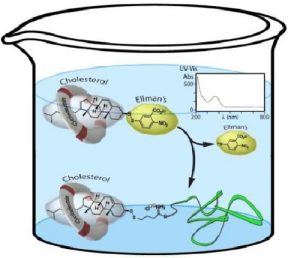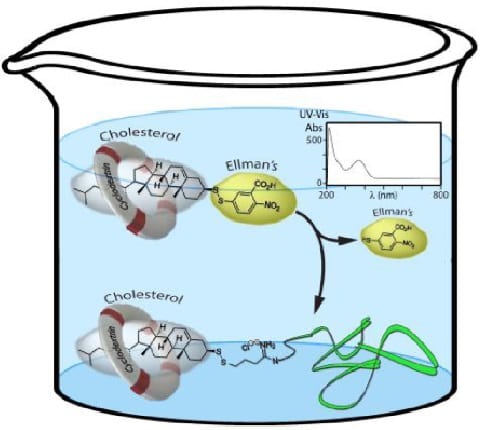 Cholesterol is an important building block in nature and a recognized tool of bio/nanotechnology. Functionalization with cholesterol is pursued for diverse biomedical and biotechnological needs such as PEGylation of liposomes as well as RNAi techniques wherein conjugation of the nucleic acid with cholesterol enhances cellular uptake and increases stability of the nucleic acid to degradation by nucleases. Modification of water-soluble polymers with hydrophobic groups such as cholesterol aims to induce formation of micelles for drug delivery. In addition cholesterol-aided linkages between polymers and liposomes are used to create subcompartmentalized assemblies as cell mimics.
Cholesterol is an important building block in nature and a recognized tool of bio/nanotechnology. Functionalization with cholesterol is pursued for diverse biomedical and biotechnological needs such as PEGylation of liposomes as well as RNAi techniques wherein conjugation of the nucleic acid with cholesterol enhances cellular uptake and increases stability of the nucleic acid to degradation by nucleases. Modification of water-soluble polymers with hydrophobic groups such as cholesterol aims to induce formation of micelles for drug delivery. In addition cholesterol-aided linkages between polymers and liposomes are used to create subcompartmentalized assemblies as cell mimics.
These (and other) applications necessitate facile, reliable techniques in bioconjugation using cholesterol. However, this molecule is not soluble in water and quite literarily “invisible” – both aspects being significant obstacles in bioconjugation using cholesterol. Alexander N. Zelikin et al. from Aarhus developed water-soluble preparations of thiocholesterol – a molecule identical to cholesterol but with a thiol group equipped instead of the natural hydroxyl. Nature-inspired thiol-disulfide chemistry was used to perform conjugation of cholesterol to polymers, peptides and hydrogels – all conducted in aqueous solutions and using UV-vis traceable reactions.
The techniques developed in this work will significantly broaden the scope and utility of cholesterol in bio- and nano-technology and specifically biomedicine.

















